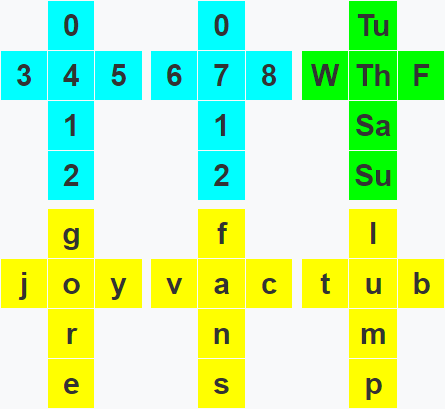“A footnote is like running downstairs to answer the doorbell during the first night of marriage.” — John Barrymore
Author: Greg Ross
The Desk Calendar
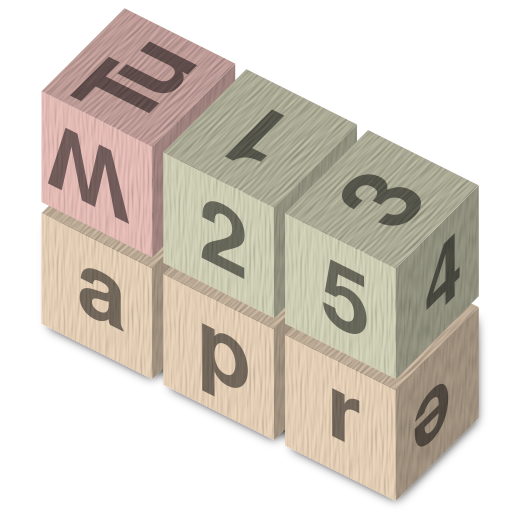
This is a variation on an old puzzle by Martin Gardner. This desk calendar currently displays the date Monday, April 25. If the six cubes are capable of displaying any day of the week and any date from January 01 to December 31, what characters appear on the unseen faces in the picture? Gardner wrote, “It is a bit trickier than one might expect.”
“The Last Bard of Dixie”
South Carolina poet J. Gordon Coogler (1865-1901) was widely mocked for this terrible couplet:
Alas! for the South, her books have grown fewer —
She never was much given to literature.
He complained,
Oh you critics! — If an author errs in a single line,
That line you’ll surely quote,
And will give it as a sample fair
Of all he ever wrote.
But he was bad everywhere:
On her beautiful face there are smiles of grace
That linger in beauty serene,
And there are no pimples encircling her dimples
As ever, as yet, I have seen.
His complete works are here.
Early Arrival

When his wife died in 1893, Brooklyn retiree Jonathan Reed had a tomb built in Evergreens Cemetery, where for 10 years he kept her company. “The Reed mausoleum was furnished just like a living room in a fine house,” read his New York Times obituary, “all the usual articles of furniture being provided. It was warmed with a fine oil stove manufactured specially for the tomb.”
Mr. Reed could never be made to believe that his wife was really dead, his explanation of her condition being that the warmth had simply left her body, and that if he kept the mausoleum warm she would continue to sleep peacefully in the costly metallic casket in which her remains were put. … According to his friends, he really believed that his wife could understand what he was saying to her.
From the hour the cemetery gates opened at 6 a.m. until they closed at 6 p.m., he was in the tomb. “The old man ate all of his meals in the mausoleum and was in the habit of holding imaginary conversations with his wife. … He always appeared to be very happy.”
A visitor eventually discovered him dying on the floor of the crypt in 1905, and he was laid to rest in the empty casket that he had prepared next to hers.
Perfect Numbers
From Lee Sallows:
As the reader can check, the English number names less than “twenty” are composed using 16 different letters of the alphabet. We assign a distinct integral value to each of these as follows:
E F G H I L N O R S T U V W X Z 3 9 6 1 -4 0 5 -7 -6 -1 2 8 -3 7 11 10
The result is the following run of so called “perfect” numbers:
Z+E+R+O = 10 + 3 – 6 – 7 = 0 O+N+E = –7 + 5 + 3 = 1 T+W+O = 2 + 7 – 7 = 2 T+H+R+E+E = 2 + 1 – 6 + 3 + 3 = 3 F+O+U+R = 9 – 7 + 8 – 6 = 4 F+I+V+E = 9 – 4 – 3 + 3 = 5 S+I+X = –1 – 4 + 11 = 6 S+E+V+E+N = –1 + 3 – 3 + 3 + 5 = 7 E+I+G+H+T = 3 – 4 + 6 + 1 + 2 = 8 N+I+N+E = 5 – 4 + 5 + 3 = 9 T+E+N = 2 + 3 + 5 = 10 E+L+E+V+E+N = 3 + 0 + 3 – 3 + 3 + 5 = 11 T+W+E+L+V+E = 2 + 7 + 3 + 0 – 3 + 3 = 12
The above is due to a computer program in which nested Do-loops try out all possible values in systematically incremented steps. The above solution is one of two sets coming in second place to the minimal (lowest set of values) solution seen here:
E F G H I L N O R S T U V W X Z –2 –6 0 –7 7 9 2 1 4 3 10 5 6 –9 –4 –3
But why does the list above stop at twelve? Given that 3 + 10 = 13, and assuming that THREE, TEN and THIRTEEN are all perfect, we have T+H+I+R+T+E+E+N = T+H+R+E+E + T+E+N. But cancelling common letters on both sides of this equation yields E = I, which is to say E and I must share the same value, contrary to our requirement above that the letters be assigned distinct values. Thus, irrespective of letter values selected, if it includes THREE and TEN, no unbroken run of perfect numbers can exceed TWELVE. This might be decribed as a formal proof that THIRTEEN is unlucky.
But not all situations call for an unbroken series of perfect numbers. Sixteen distinct numbers occur in the following, eight positive, eight negative. This lends itself to display on a checkerboard:
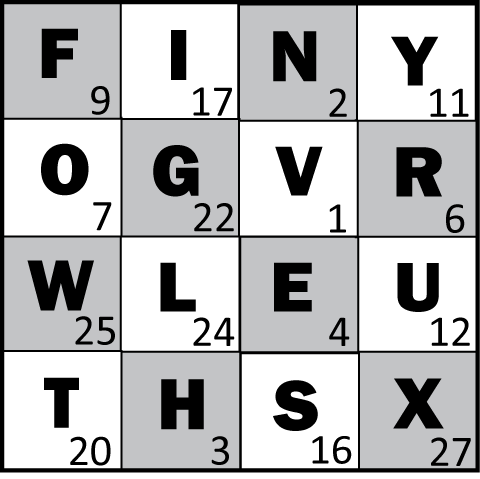
Choose any number on the board. Call out the letters that spell its name, adding up their associated numbers when on white squares, subtracting when on black. Their sum is the number you selected.
(Thanks, Lee.)
Half Measures
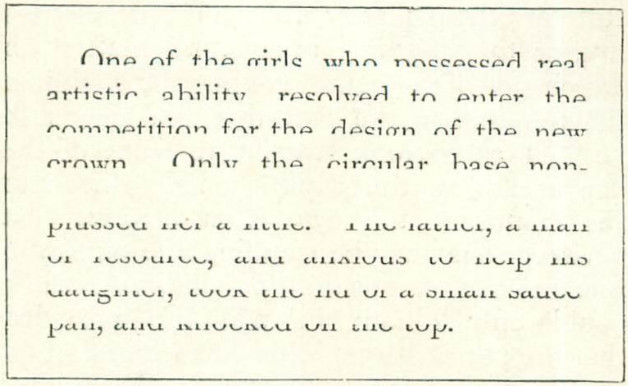
When we read type we imagine that we read the whole of the type — but that is not so; we only notice the upper half of each letter. You can easily prove this for yourself by covering up the upper half of the line with a sheet of paper (being careful to hold the paper exactly in the middle of the letters), and you will not, without great difficulty, decipher a single word. Now place the paper over the lower half of a line, and you can read it without the slightest difficulty.
— George Lindsay Johnson, “Some Curious Optical Illusions,” Strand, October 1897
11/04/2024 UPDATE: In the experimental writing system Aravrit, devised by typeface designer Liron Lavi Turkenich, the upper half of each letter is Arabic and the lower half is Hebrew:
(Thanks to reader Djed F Re.)
Canting Arms
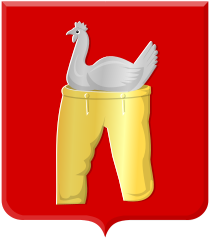
The village of Hensbroek in North Holland takes its name from the personal name Hein and the Dutch cognate of brook, i.e., “Henry’s brook.”
Magnificently, the municipal coat of arms interprets it instead as “hen’s breeches” — and depicts a chicken wearing trousers.
Spelling Aid
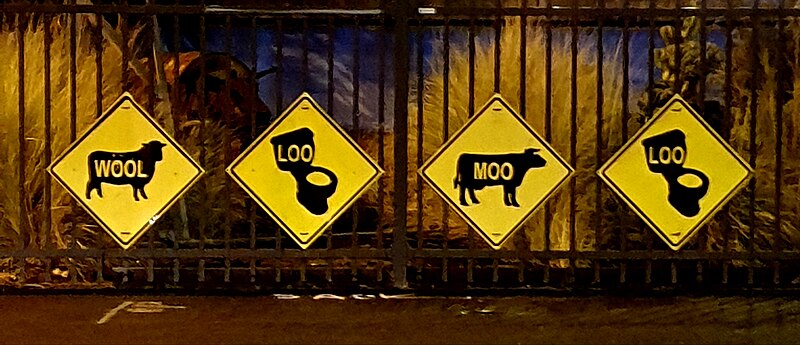
These signs are posted on Cathedral Street in Woolloomooloo, New South Wales.
Hermae
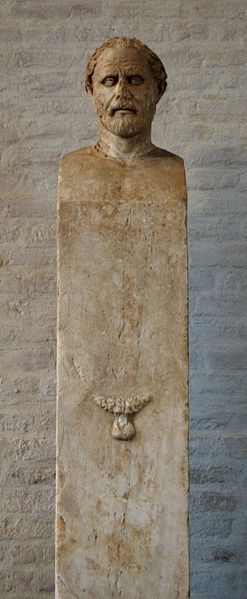
Ancient Athenians would sometimes encounter a remarkable sculpture on roads and in public places: The bearded head of the god Hermes set on a squared pillar of stone, with male genitals carved at the appropriate height. Hermes had been a phallic god before becoming a guardian of merchants and travelers, and so was associated with fertility, luck, roads, and borders. The hermae served as a form of protection from evil and were sometimes anointed with oil or bedecked with garlands.
Plato writes that “figures of Hermes” were set up “along the roads in the midst of the city and every district town” “with the design of educating those of the countryside,” sometimes by bearing edifying inscriptions. The sculptures did not always depict Hermes — this one, from the Athenian Agora, honors Demosthenes. The practice spread eventually to Rome, where the figures were known as mercuriae.
(Peter Keegan, Graffiti in Antiquity, 2014.)
“A Statesman”
A Statesman who attended a meeting of a Chamber of Commerce rose to speak, but was objected to on the ground that he had nothing to do with commerce.
‘Mr. Chairman,’ said an Aged Member, rising, ‘I conceive that the objection is not well taken; the gentleman’s connection with commerce is close and intimate. He is a commodity.’
— Ambrose Bierce, Fantastic Fables, 1899

